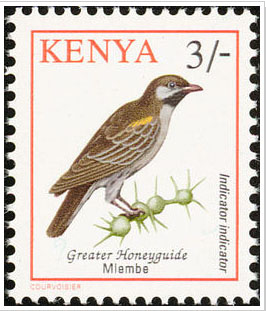On a dusty African trail, a bird flutters around your head, showing off orange shoulders and white tail feathers -- and then perches a short distance away, making a chirring sound. Most birds are afraid of humans, but this animal is different. This bird -- Indicator indicator -- is trying to tell you something. It flys just out of sight, tempting you to follow. If you track the Honeyguide on a haphazard course that might run as far a mile, you will arrive at a beehive. The bird will perch silently nearby, waiting for you to pull apart the hive and begin harvesting the wax comb, dripping with honey. Once you are finished, it will be the bird's turn -- not for the honey, but to eat the larvae and rich wax that is part of the bird's diet. |
 |
This may sound like a scene from a children's book, but adaptations in the Greater Honeyguide's beak and feathers suggest it is actually an ancient tradition stretching back to human origins. These wax-eating birds were first documented by missionaries who noticed them flying into the church to devour the candles, but most tribes have long treated the Honeyguide as a respected partner, and even summon birds with special calls. The birds are willing to befriend any larger animal that might cooperate by following them to a golden honey feast -- including badgers, baboons or even mongooses, suggesting the Honeyguides might be using a trial and error technique to locate their partners. However, the easy availability of sweets in modern Africa makes it harder to find human friends who are willing to brave a hive of angry bees, and since 1950, the behavior of the birds is reported to be dying out. However, if you are befriended by a Honeyguide, don't forget your partner. Otherwise the next time -- according to tribal elders -- the Honeyguide will guide you to a lion. |
 Custom Search Custom Search |
|
Got a comment? E-Mail us at Feedback@BirdMinds.com